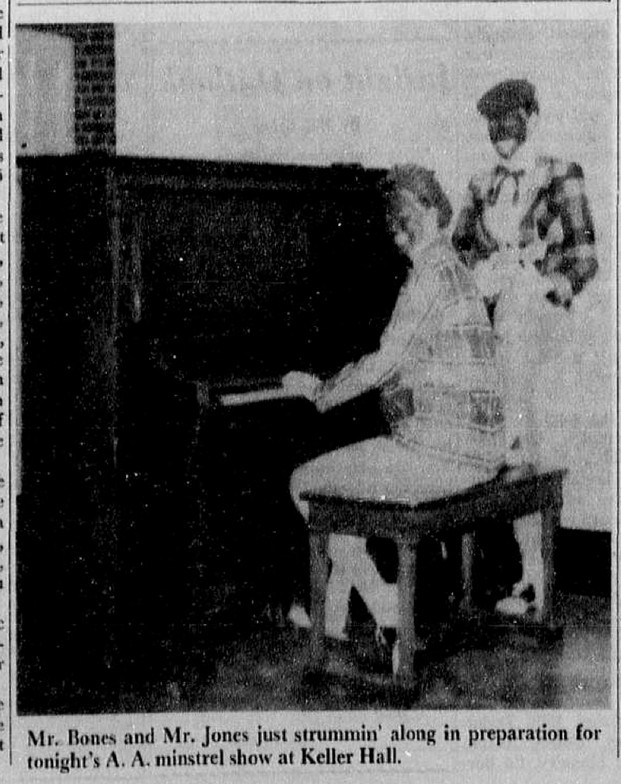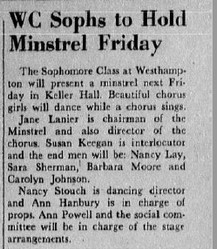Keller Hall, Richmond’s Minstrel History & Modlin’s Legacy
Introduction
Text-to-speech Audio
Images
Students prepare for a minstrel show in Keller Hall in 1957. (Source: University of Richmond Collegian)

Westhampton College seniors of 1963 advertise their class minstrel show being held that night in Keller Hall. (Source: University of Richmond Collegian)

WC sophomores will present new songs and skits in their finished minstrel show titled, “Tarlight Tymphony.” (Source: University of Richmond Collegian)

George Modlin posing next to Westhampton Lake. (Source: Pinterest, Professional & Continuing Studies - UR)

Backstory and Context
Text-to-speech Audio
Keller Hall is named after May Lansfield Keller, who served as the first dean of Westhampton College from 1914 through 1946.1 Keller’s tenure as Dean of Westhampton briefly overlapped with the presidency of George M. Modlin (1946-1971), for whom the Modlin Center for the Arts is named — now located in the next building over.
While Keller Hall today is used as a residential building that also houses the Global House, a residential program with the aim of cultivating diversity and interest in global issues, it was the venue of choice for Westhampton College activities, specifically minstrel shows, after it was completed in 1937.
Throughout 19th century American history, minstrel shows exploited exaggerated and false notions of the Black population for the sake of white entertainment. These shows were typically performed by white men donning Blackface makeup. Moreover, minstrel shows often portrayed slaves as being happy on the plantation and incapable if freed. The popularity of minstrelsy lasted well into the 20th century. Richmond and Westhampton College students organized and participated in minstrel shows, such as “Tarlight Tymphony” in 1952, homecoming minstrel performances, and countless others.
That these performances continued throughout the 1950s illustrates resistance to the Civil Rights Movement on the University of Richmond’s campus, as the movement gained momentum. Although the university desegregated in 1968, the minstrel tradition of performing in Blackface was documented even after the university had admitted its first residential African American student, Barry Greene.
The continuation of these traditions reminds of the challenging campus climate that was experienced by the University of Richmond's first African American students, including Barry Greene, Madieth Malone, and Isabel Thomas, and how they maneuvered the University of Richmond.
Despite experiencing discrimination while attending the school, Barry Greene recalls feeling supported by the university community when President Modlin wrote him a letter urging him to return to campus and offering his support after Greene’s father passed away tragically.2
While Modlin’s gesture to Greene suggests a sympathetic administrator, the historical record conveys a complex story of Modlin’s presidency. Documents show a number of pressures being exerted on Modlin, from alumni who supported and opposed desegregation to the Baptist-affiliated organizations that influenced the university in regards to race-related issues.3 The Supreme Court decision in Brown v. Board of Education was handed down in 1954, but it wasn’t until 1968 that the University campus would desegregate.
The juxtaposition of historical materials, showing both the popularity of minstrel shows and President Modlin’s support for Greene, illustrates a tension within a university that was both reluctant to embrace integration and afraid to fall behind the times.
Cite This Entry
Rachel/Tucker and Nicole Maurantonio. "Keller Hall, Richmond’s Minstrel History & Modlin’s Legacy ." Clio: Your Guide to History. December 10, 2018. Accessed August 18, 2025. https://theclio.com/entry/70782
Sources
2 African-American alumni discuss Richmond experience. 04/11/2014. https://news.richmond.edu/features/article/-/11959/african-american-alumni-discuss-richmond-experience-university-commemorates-Black-history-month-with-alumni-panel-.html?sma=sm.000txws5g12pbdf2rdy1tee8aixjc.
3 Duplessie, Bailey, et al. George Modlin's Segregated University of Richmond. Race & Racism at the University of Richmond. https://memory.richmond.edu/exhibits/show/modlin.

